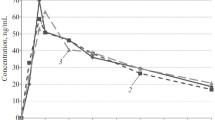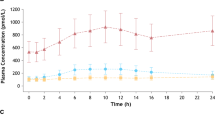Summary
In 12 healthy male volunteers, molsidomine 1, 2 and 4 mg i.v. increased resting heart rate and decreased systolic blood pressure, the latter still being affected after 8 hours. After single oral doses of 1 and 2 mg, systolic pressure tended to be reduced for 90 minutes and exercise heart rate tended to be increased. After oral treatment with 2 mg molsidomine three times daily for 1 week, the pharmacokinetic parameters and the effects on heart rate and blood pressure after the final dose were not different from those after the first dose. The terminal half-life was independent of dose and route of administration. Clearance and distribution volume were not dose-dependent. The bioavailability of a 2 mg oral dose of molsidomine was 44%. Inter-individual variation in heart rate, blood pressure and pharmacokinetics was observed.
Similar content being viewed by others
References
Milei J, Vazquez A, Lemus J (1980) Double-blind controlled trial of molsidomine in hypertension. Eur J Clin Pharmacol 18: 231–235
Guerchicoff S, Vazquez A, Kunik H, Drajer S, Diaz F (1978) Acute double blind trial of a new anti-anginal drug: Molsidomine. Eur J Clin Pharmacol 13: 247–250
Majid PA, DeFeyter PJF, Van der Wall EE, Wardeh R, Roos JP (1980) Molsidomine in the treatment of patients with angina pectoris. Acute hemodynamic effects and clinical efficacy. N Engl J Med 302: 1–6
Dell D, Chamberlain J (1978) Determination of molsidomine in plasma by high performance liquid column chromatography. J Chromatogr 146: 465
Rowland M, Tozer T (1980) Clinical pharmacokinetics: Concepts and applications. Sections I and II. Lea and Febiger, Philadelphia, pp 9–134
Kirk RE (1968) Experimental design. Procedures for the behavioral sciences. Brooks/Cale Publishing Company, Belmont, CA, USA
Duncan DB (1955) Multiple range and multiple F-tests. Biometrics 11: 1–42
Shapiro SS, Wilk MB (1965) Analysis of variance test for normality (complete samples). Biometrics 52: 591–611
Yates F (1933) The analysis of replicated experiments when the field results are uncomplete. Emp J Exp Agr 1: 129–142
Karsch KR, Rentrop KP, Blanke H, Kreuzer H (1978) Haemodynamic effects of molsidomine. Eur J Clin Pharmacol 13: 241–245
Aptecar M, Otero y Garzon CA, Vasquez A, Varini S, Collia L, Esteguy A, Caruso S (1981) Hemodynamic effects of molsidomine vasodilator therapy in acute myocardial infarction. Am Heart J 101: 369–373
Vogt A, Kreuzer H (1982) Comparative study of haemodynamic effects of oral molsidomine and isosorbide dinitrate in man. Eur J Clin Pharmacol 23: 11–14
Ostrowski J (1979) Zur Pharmakokinetik von Corvaton (Molsidomine) beim Menschen. In: Lochner W, Bender F (eds) Molsidomin. Urban & Schwarzenberg, München Wien Baltimore, pp 69–73
Weidemann H, Ostrowski J, Voegele D, Schalla U, Resag K (1982) Ergebnisse von Belastungs-EKG-Serienuntersuchungen in Abhängigkeit der Molsidomin-Blutspiegel bei Molsidomin retard 8 mg im Vergleich zu Molsidomin 2 mg. Herz/Kreislauf 5: 268–273
Strasser R, Klepzig H, Ostrowski J, Resag K (1983) Wirkung von Molsidomin bei koronarer Herzkrankheit nach oraler und sublingualer Gabe. Klinische-pharmakokinetische Korrelationstudie. Dtsch Med Wochenschr 125: 156
Rohl D, Lehmann K (1980) Molsidomin in Ergometerversuch. Dtsch Med Wochenschr 105: 1216–1219
Ostrowski J, Schweizer P, Erpel R, Claus G, Resag K (1981) Correlation of pharmacokinetic data to clinical effect of molsidomine. First European Congress of Biopharmacology and Pharmacokinetics. Clemont-Ferraud 1–3 April 1981. Vol 3: 418–424
Tanayna S, Nakai Y, Fujita T, Suzoki Z (1974) Biotransformation of Molsidomine, a new anti-anginal agent in rates. Xenobiotica 4: 175
Rowland M, Tozer T (1980) Clinical pharmacokinetics: Concepts and applications. Lea and Febiger, Philadelphia, chapter 14, p 197
Oltmanns D, Friedmann W, Ostrowski J (1982) Zur Pharmakokinetik von Molsidomin in höherer Dosierung bei der Behandlung des frischen Herzinfarkts. Herz-Medizin 5: 141
Author information
Authors and Affiliations
Rights and permissions
About this article
Cite this article
Bergstrand, R., Vedin, A., Wilhelmsson, C. et al. Intravenous and oral administration of molsidomine, a pharmacodynamic and pharmacokinetic study. Eur J Clin Pharmacol 27, 203–208 (1984). https://doi.org/10.1007/BF00544046
Received:
Revised:
Accepted:
Issue Date:
DOI: https://doi.org/10.1007/BF00544046




